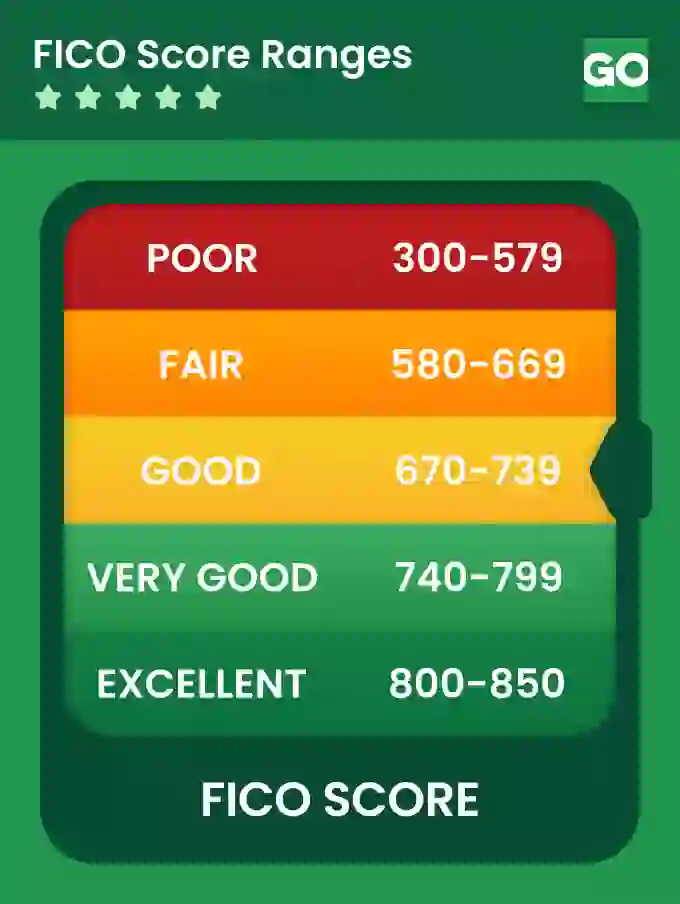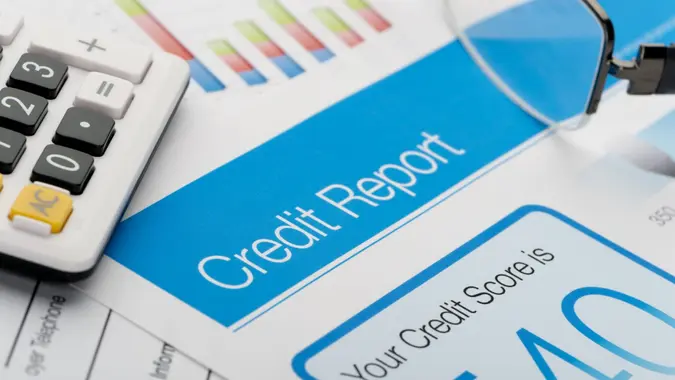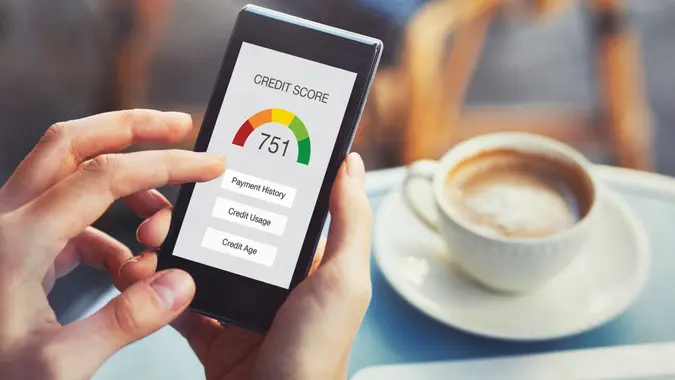What Are the Different Credit Score Levels and How Can You Improve Yours?

Commitment to Our Readers
GOBankingRates' editorial team is committed to bringing you unbiased reviews and information. We use data-driven methodologies to evaluate financial products and services - our reviews and ratings are not influenced by advertisers. You can read more about our editorial guidelines and our products and services review methodology.

20 Years
Helping You Live Richer

Reviewed
by Experts

Trusted by
Millions of Readers
Credit score levels range from poor to excellent. The score level is where you fall within that range: poor, fair, good, very good or excellent. Lenders use credit scores to figure out how likely you are to repay debt on time and according to the agreement.
Scoring model companies use data to determine your score. Even though there are different companies, FICO and VantageScore are the two most common — 90% of the top lenders use FICO score ranges when reviewing applications.
Good To Know
The closer your score is to excellent, the more financial opportunities you’ll have. It makes it easier to get loans, secure low interest rates, apply for top credit cards and qualify for rental housing.
FICO Score Ranges and What They Mean
The FICO scoring model has five different score ranges. The ranges provide a simple way to understand your score.
Every credit score falls within one of the ranges, and it can help you determine whether you’ll qualify for a loan or credit card.

300-579: Poor Credit
If your score falls between 300 and 579, you are in the “poor” credit range. Borrowing money is more expensive and might not be possible with every lender.
Getting loans or credit cards is usually more complicated, and lenders might deny your application when you apply. You may have to settle for a high interest rate or use a secured credit card to borrow money.
580-669: Fair Credit
Scores between 580 and 669 are in the “fair” range. It’s a little easier to qualify for loans in this range since most lenders require a score of at least 600. But you won’t usually be able to get the best terms.
You can expect to pay higher interest rates on loans, and even then, some of the top credit cards are usually still out of reach.
670-739: Good Credit
You can qualify for most loans and credit cards once your score falls within the “good” range. You can also get competitive interest rates that will help you save money.
Once you’re in this range, one of the biggest differences is that you’ll have options. Instead of qualifying for one or two loans, you can compare rates from multiple lenders to find the best deal.
740-799: Very Good Credit
Borrowers with “very good” credit have scores between 740 and 799. Once in this range, you can access better financial products — credit cards with large sign-up bonuses, loans with no fees and low interest rates.
As an added perk, you’ll also be able to get higher credit limits. Finding solid loan products is much easier when your credit falls within this range.
800-850: Excellent Credit
Once you have “excellent” credit, you can secure the best rates and loan terms. You also have higher chances of approval for premium credit cards and mortgages.
What Affects Your Credit Score?
Different factors impact your credit score. Below, you can see how FICO creates your score, including how much each category is worth.
- Payment History — 35%
- This is how you make credit card and loan payments. Late or missed payments can lower your score.
- Credit Utilization — 30%
- Using too much of your available credit hurts your score.
- For example, say you have access to $5,000 of credit. If you use it all, your score would go down. If you only use some of it, your score can increase.
- Credit History Length — 15%
- As your credit history increases, your score increases.
- Here’s an example: A borrower with at least 10 years of credit history might have a higher score than someone with only two years.
- New Credit Inquiries — 10%
- Applying for new loans or credit cards temporarily decreases your score. Similarly, too many applications in a short time lowers your score.
- Credit Mix — 10%
- A mix of credit cards, loans and other accounts helps increase your score. It shows that you’re a responsible borrower who can handle different types of debt.
How Do Credit Score Levels Affect Your Financial Life?
Even though it’s just a number, credit scores impact your life. Here’s a look at some of the most common ways credit score levels change your finances:
- Loan approvals and interest rates: A higher score can get you better loan terms, including easier access and lower interest rates. It’s also much cheaper to borrow money.
- Credit card eligibility: With a solid credit score, you can qualify for premium cards with competitive interest rates and useful bonus offers, including travel points.
- Insurance rates: Insurance companies in most states use insurance-based credit scores to determine rates. A higher score can result in lower premiums.
- Apartment rentals: Most landlords include a check credit score in the application process. Higher credit scores indicate that applicants are more reliable, which can make you more likely to get the rental.
- Employment screenings: Some employers consider credit scores when deciding who to hire. Applicants with higher scores might find it easier to get the job.
How To Improve Your Credit Score: 5 Steps To Take
The good news about credit scores is that the numbers aren’t permanent. You can take the following steps to improve your score.
Step 1: Pay Bills on Time
On-time bill payments help increase your score. You’ll also avoid late payments and interest fees, so it’s a win-win.
Step 2: Keep Credit Utilization Below 30%
Most experts recommend keeping your credit utilization below 30%. For example, imagine you can access $10,000 of credit through cards and loans. If you only owe $3,000, you have a utilization rate of 30%.
Step 3: Check and Dispute Credit Report Errors
You can check your credit report for free at AnnualCreditReport.com. You can dispute the error with the credit bureaus If anything is inaccurate.
Step 4: Avoid Opening Too Many New Accounts
Only open new credit and loan accounts as necessary. Opening too many new accounts can hurt your score.
Step 5: Apply for a Secured Card or Become an Authorized User
If you need to build credit, apply for a secured card or become an authorized user on a family member’s card.
FAQ
Here are the answers to some of the most frequently asked questions about credit score levels.- What is considered a good credit score?
- Most lenders consider 670 to 739 a good credit score.
- Scores higher than 739 fall into the "very good" or "excellent" range.
- Once you have a good score, getting approved for loans and credit cards is easier.
- How long does it take to improve a credit score?
- It doesn't take long to improve your credit score once you start making on-time payments and reducing the amount you owe. Your payment history and credit utilization account for 65% of your score. Once you make changes, it can improve quickly.
- Do different credit bureaus show different scores?
- Credit bureaus might show different scores because each company uses a unique scoring model. But the scores are usually within the same range. Check your credit report for errors if you notice a significant difference.
- What happens if my credit score drops?
- When your credit score drops, qualifying for loans and credit cards might be more challenging. Rates are usually higher, even if you qualify. But if you have a slight drop and stay within the same score level, you probably won't notice a difference. Most banks offer free credit monitoring so you can get alerts about changes.
- Can I get a mortgage with a fair credit score?
- You might be able to get a mortgage with a fair credit score, but it depends on the lender.
- For example, you need a score of at least 500 to qualify for an FHA mortgage, but some lenders have higher score requirements.
Our in-house research team and on-site financial experts work together to create content that’s accurate, impartial, and up to date. We fact-check every single statistic, quote and fact using trusted primary resources to make sure the information we provide is correct. You can learn more about GOBankingRates’ processes and standards in our editorial policy.
- myFICO. "What is a FICO® Score?"
- USA.gov. 2024. "Understand, get, and improve your credit score."
- myFICO. "What's in my FICO® Scores?"
 Written by
Written by  Edited by
Edited by 






















